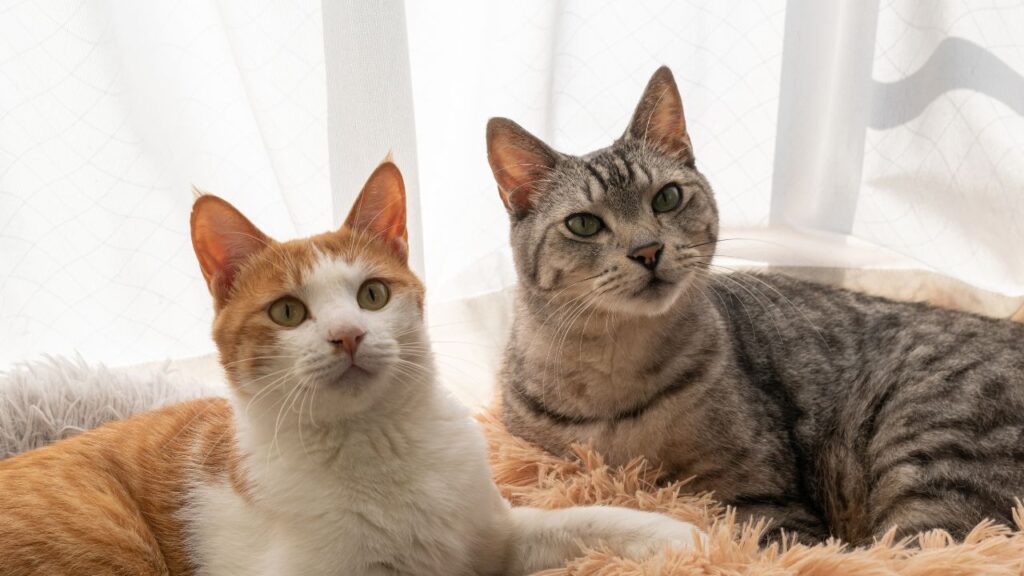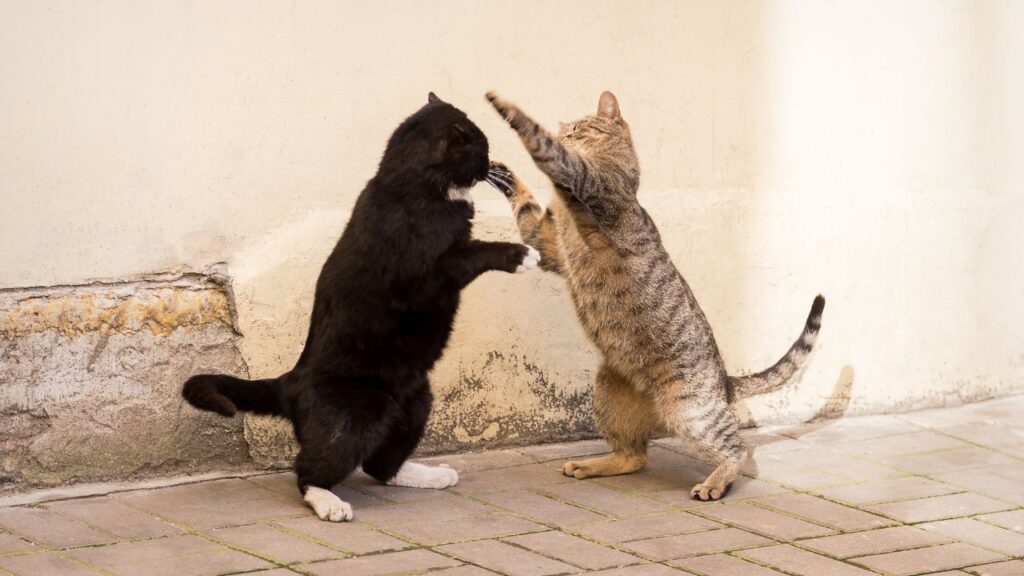Training a single cat can be a challenge, so what about training two cats at once? If you’ve ever wondered how to train two cats at once simultaneously, you’re not alone. Whether bringing in a new kitten or trying to get your existing cats to coexist peacefully while learning new tricks, the process can seem daunting. But don’t worry—training two cats together is entirely possible, and with the right strategy, it can even be a rewarding experience for both you and your feline friends.
In this article, we’ll explore everything you need to know about training two cats at once, from understanding their individual personalities to creating a training routine that works for both. We’ll also go over practical tips, common challenges, and effective techniques that will help you build a harmonious, well-behaved multi-cat household.
Let’s dive in!
Contents
The Basics: Why Training Two Cats Can Be Different
Before we jump into the how, let’s talk about why training two cats can be trickier than training just one. Cats, as we know, are independent creatures, and each one has its own personality, preferences, and needs. When you introduce a second cat into the mix, you’re not just training two individual cats—you’re also managing their interaction with each other. This means you have to factor in their social dynamics, communication styles, and how they respond to each other.
1. Individual Personalities Matter
Each cat has its own quirks, which makes training two cats together a delicate balancing act. One cat may be more food-motivated, while the other might respond better to affection or play. Some cats might be social butterflies, while others are shy and reserved. You’ll need to tailor your training approach to fit each cat’s personality.
2. Managing the Group Dynamic
When you train two cats at once, you’re not just training them as individuals; you’re also encouraging positive interactions between them. For example, if one cat is more dominant, they may try to take control of the training session, while the other cat might get frustrated or confused. Understanding how they interact is crucial to keeping the peace and ensuring both cats learn what they need to.
3. Patience is Key
Training multiple cats requires more patience than training a single cat. While one cat might pick up a new trick in minutes, the other may take days or even weeks. That’s okay! With a consistent and flexible training schedule, both cats will eventually catch on at their own pace.

Preparing to Train Two Cats
Now that you have a sense of why training two cats can be a challenge, let’s talk about how to set up the right environment and training routine for success. Here are some steps to help you prepare for multi-cat training:
1. Create a Calm, Quiet Space
Cats are easily distracted, so it’s important to create a training environment that’s calm and free of interruptions. A quiet room where both cats can focus on the task at hand without too much noise or commotion will help keep them engaged.
- Tip: Choose a space with minimal distractions, like a spare bedroom or a quiet corner in your home. Close the windows to block outside noise, and make sure the room is free of other pets or people during training sessions.
2. Separate the Cats During Training
It might seem counterintuitive, but sometimes it’s best to start by training the cats separately. This allows each cat to focus on the task without feeling competitive or distracted by the other.
- Tip: Start with short, individual sessions for each cat. Once they’ve mastered a trick on their own, you can begin incorporating them together in group training sessions.
3. Use Positive Reinforcement
No matter how many cats you’re training, positive reinforcement is key. Reward your cats with treats, praise, or affection whenever they do something correctly. This builds a strong association between the desired behavior and the reward, encouraging them to repeat it.
Training Techniques for Two Cats
Training two cats simultaneously requires adapting your usual training methods to fit both cats. Here are some tried-and-true techniques for training multiple cats at once:
1. Start with Basic Commands
If you’re training both cats together, begin with simple commands like “sit” or “come.” These foundational commands will help establish a routine and set the tone for more advanced training.
- Tip: Start with just one command at a time. Don’t overwhelm your cats by teaching too many things at once. Once both cats have learned a command, you can move on to more complex tricks.
2. Use a Clicker for Consistency
Clicker training is a popular method for training cats because it provides clear and consistent feedback. The click sound serves as a marker to let your cats know they did something right, and it helps them understand what behavior is being rewarded.
- Tip: Use the clicker for both cats during training sessions. This will create consistency and ensure they both learn the same way, even if one cat is quicker to catch on than the other.
3. Training Sessions Should Be Short
Cats have short attention spans, so keep your training sessions brief—no longer than 10-15 minutes at a time. This is especially important when training two cats because you don’t want them to get overwhelmed or distracted. Multiple short sessions throughout the day are more effective than one long session.
- Tip: Break the training into smaller parts, especially when training them together. Start by focusing on one cat, then move on to the other. By the end of the session, they’ll both have had their turn to shine!
4. Reinforce Positive Interactions Between Cats
When training two cats, one of your goals should be to encourage positive interactions between them. This might mean rewarding them for sitting calmly near each other or playing together. It’s important that they associate each other with positive experiences.
- Tip: If one cat becomes overly dominant or aggressive during a training session, take a break and separate them for a few minutes. This will prevent frustration and give them time to calm down.
Dealing with Common Challenges
Training two cats at once comes with its own set of challenges. Here are a few common issues you might encounter and how to handle them:

1. Fighting or Aggression
It’s not uncommon for cats to compete for attention or resources, especially when they’re learning something new. If you see one cat becoming aggressive or overly dominant during training, it’s important to step in calmly and separate them.
- Tip: Provide each cat with their own space and treat them equally. If one cat is consistently acting out, you may need to spend more one-on-one time with them to reduce jealousy and frustration.
2. Distractions
Cats can easily get distracted, so it’s important to minimize outside interference during training sessions. If one cat is particularly distracted, try training them separately to maintain focus.
- Tip: Gradually reintroduce the cats to training together once they’re more comfortable with the routine. Use toys or other forms of enrichment to keep their attention on you.
3. Different Learning Paces
Not all cats learn at the same speed. One cat may catch on quickly, while the other might take a bit longer to grasp the concept. This is perfectly normal, but it can be frustrating.
- Tip: Be patient with each cat, and avoid comparing them. Celebrate each small success, and remember that consistency and positive reinforcement will pay off in the long run.
Frequently Asked Questions
1. Can I train both cats at the same time?
Yes, you can train both cats at the same time, but you may want to start with separate sessions until both cats are comfortable. Once they’ve mastered basic commands, you can work on group training.
2. How long will it take for my cats to learn something new?
Each cat is different, so the time it takes to learn a new command or behavior can vary. Typically, training sessions should last no more than 15 minutes, and consistency is key. You’ll likely see progress in a few weeks.
3. What if one cat isn’t responding to training?
If one cat isn’t responding, it may be due to distraction or stress. Try reducing the distractions and focusing on smaller steps. If needed, work with each cat individually before reintroducing them to group training.
Conclusion
Training two cats at once can be a fun and rewarding challenge. With the right approach, patience, and positive reinforcement, you’ll be able to teach both cats important skills and strengthen the bond between you and your furry companions. Remember to take it one step at a time, keep training sessions short and sweet, and celebrate each small success along the way.
Good luck, and may the training sessions be filled with progress and plenty of purrs!

